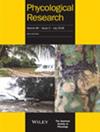Picochloropsis malayensis gen.
IF 1
4区 生物学
Q2 MARINE & FRESHWATER BIOLOGY
引用次数: 0
摘要
摘要废水中富含大量磷酸盐,可被视为重要的肥料来源。一些微藻类从废水中吸收磷酸盐,并以聚磷酸盐(polyP)的形式储存起来。因此,生物磷回收工艺近来备受关注。然而,废水中通常含有丰富的铵,因此用于磷回收的微藻类应能耐受铵的成分。本研究从淡水、咸水和海水中分离出 151 种微藻。其中,11 个菌株在富氨培养基中表现出较高的生长率。其中,来自海洋环境的菌株 SLG4-06 显示出最高的聚磷酸酯积累率,被选为最有潜力从废水中回收磷的藻类。根据菌株 SLG4-06 的形态学和超微结构特征,以及核编码的 18S rDNA 和叶绿体编码的 rbcL 的系统进化分析,我们认为该菌株属于 Chlorellales, Trebouxiophyceae 中的 Picochloropsis malayensis gen.由于 P. malayensis 可在海水和淡水环境中生长,因此可能适用于盐度波动较大的海水养殖池塘的废水处理。本文章由计算机程序翻译,如有差异,请以英文原文为准。
Picochloropsis malayensis gen. et sp. nov. (Chlorellales, Chlorophyta), an ammonium tolerant, polyphosphate‐accumulating microalga from seawater
SUMMARYThe significant concentrations of phosphate in wastewater can be considered as an important fertilizer source. Some microalgae uptake phosphate from wastewater and store it in the form of polyphosphate (polyP). Therefore, biological phosphorus recovery processes have been attracting significant attention recently. However, wastewaters are often rich in ammonium, and so microalgae used for phosphorus recovery should be tolerant of this component. In the present study, 151 microalgae were isolated from freshwater, brackish water and seawater. Among them, 11 strains showed higher growth rates in ammonium‐rich media. Of these, the strain SLG4‐06 originating from a marine environment showed the highest polyP accumulation rate and was selected as the most potential alga for phosphorus recovery from wastewater. Based on the morphological and ultrastructural characteristics and phylogenetic analyses of nuclear‐encoded 18S rDNA and chloroplast‐encoded rbcL of strain SLG4‐06, we propose Picochloropsis malayensis gen. et sp. nov. for this strain in the Chlorellales, Trebouxiophyceae. Because P. malayensis can grow in both seawater and freshwater environments, it may be suitable for wastewater treatment in marine aquaculture ponds with widely fluctuating salinity levels.
求助全文
通过发布文献求助,成功后即可免费获取论文全文。
去求助
来源期刊

Phycological Research
生物-海洋与淡水生物学
CiteScore
3.60
自引率
13.30%
发文量
33
审稿时长
>12 weeks
期刊介绍:
Phycological Research is published by the Japanese Society of Phycology and complements the Japanese Journal of Phycology. The Journal publishes international, basic or applied, peer-reviewed research dealing with all aspects of phycology including ecology, taxonomy and phylogeny, evolution, genetics, molecular biology, biochemistry, cell biology, morphology, physiology, new techniques to facilitate the international exchange of results. All articles are peer-reviewed by at least two researchers expert in the filed of the submitted paper. Phycological Research has been credited by the International Association for Plant Taxonomy for the purpose of registration of new non-vascular plant names (including fossils).
 求助内容:
求助内容: 应助结果提醒方式:
应助结果提醒方式:


